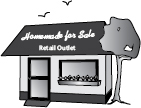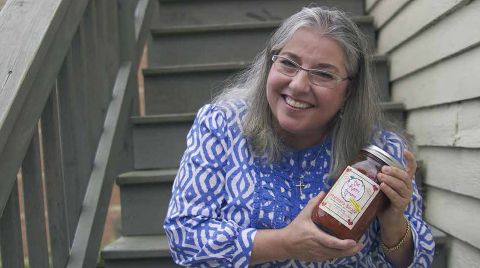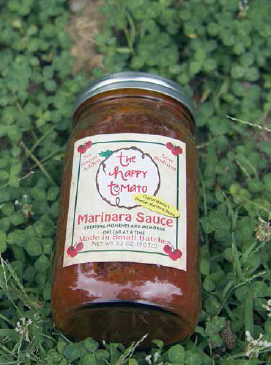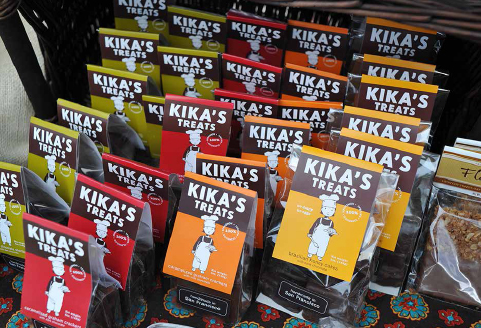
Multiple Markets and Money Matters

AS YOU RAMP UP YOUR PRODUCTION along the continuum of scaling up your operations — perhaps moving from your home kitchen to a rented kitchen or renovated commercial space on your property — you’ll need to be particularly attentive to every aspect of your business. The scope of your operations, importance of marketing — especially packaging and pricing — and impact of competition will all be magnified.
At this point, profit is no longer a given, and the potential for financial failure can be devastating if you don’t have a carefully devised and thorough plan in place. Once you head down the path of renting or building your own commercial kitchen or contracting out to a co-packer to produce your product for you, you may find that being the baker, canner or granola bar-maker takes a back seat to running the business itself. This may be a great thing or take you away from what you love most: having your fingers in real dough.
There’s also the opportunity to hit the specialty food Powerball with your product or create a viable and exciting full-time enterprise that makes a career in a cubicle obsolete. There’s the possibility to pull in a six-figure salary or sell off your enterprise and retire a millionaire. You may be putting your cookies up against Famous Amos or Mrs. Fields. Markets are everywhere, and funds to fuel your expansion may be just a click away, thanks to new “crowdsourcing” financing options available on the Internet.
This chapter will delve into a few of the many market opportunities open to you. It explores some realities regarding how your operations must change by default of your expansion plans and the regulatory environment you now face. It also provides some financial avenues you might want to pursue, outside a commercial loan from a bank. At this stage of the game, there’s no such thing as a one-size-fits-all strategy.
As mentioned previously, we’ve written this book for entry-level food entrepreneurs. We’ll leave it to other books and resources already available for a more exhaustive examination of issues related to your expansion into a full-blown, full-time food enterprise.
In a licensed food production facility and with a food processor permit, you can sell wholesale, potentially to the world. As discussed earlier in this book, some cottage food laws also permit sales via indirect or wholesale channels. Your markets could be specialty stores; institutions like schools, restaurants, hospitals or supermarkets, or by mail order only. Your choice may be limited only by your financial means, access to capital, energy level or perseverance.
In many cases, when CFOs grow big, they’re selling products wholesale in the specialty food industry, defined by the Specialty Food Association as:
foods and beverages that exemplify quality, innovation and style in their category. Their specialty nature derives from some or all of the following characteristics: their originality, authenticity, ethnic or cultural origin, specific processing, ingredients, limited supply, distinctive use, extraordinary packaging or specific channel of distribution or sale. By virtue of their differentiation in their categories, such products maintain a high perceived value and often command a premium price.
Specialty foods are hot, according to the Specialty Food Association; sales have grown 22 percent between 2010 and 2012 and topped $85 billion in 2012. Grocery retailers are the primary distribution of specialty food products, but such products can also be sold through other channels including some already familiar to CFOs, namely farmers’ markets and by direct order.
Grocery Retailers
Your packaged products may line the shelves of grocery stores, gourmet food shops and specialty food retailers, large and small. Regional specialty food stores, food cooperatives and other retailers might focus on health foods, specialty foods, seasonal or year-round gifts or items that are made locally or regionally.
Included among the list of retailers might be the following:
• Supermarkets, like Safeway, Kroger and BI-LO
• Specialty natural foods grocers, like Whole Foods Market and The Fresh Market
• Big-box retailers, like Costco and Sam’s Club
To reach these retailers, one of the more effective routes to market your products will likely be through exhibiting at a trade show where you can take orders from retailers or distributors in the markets you wish to serve.
Direct-to-customer Sales
When you scale up to a point where boxes of product become cases or pallets, you’ll need a sales force to accomplish what you once did yourself. No one can be in two or more places at the same time, so plan on hiring sales staff to work your booths or fulfill orders as they come in via telephone, text or the Internet. When selling wholesale, many food entrepreneurs contract with brokers who take a commission on every order they secure on your behalf.
Mail Order
By producing in a licensed commercial kitchen facility, suddenly you can ship your product to customers anywhere they can receive a package within the US. Packaging your product for safe transport, plus the added cost and labor associated with such, will be important variables to consider when determining a viable and profitable business model.
Mail-order specialty food catalogs are another route to reach out to potential first-time customers. Getting one or more of your products listed in these catalogs may be a relatively affordable way to build relationships with new customers.
Institutions Serving Patrons
Institutional sales may include supplying schools, restaurants, hotels and, even, hospitals. Sales to these outlets are for consumption by the patrons they serve. For example, your individually packaged, specialty, gluten-free graham crackers could be the perfect item for an institution unwilling or unable to make them in-house.
![]()
“One of the greatest strengths small food businesses have is the ability to think and quickly act outside of standard business models to meet customer needs in new and unique ways. This might include providing healthy snacks to corporations for their employees, creating subscriber-based food boxes based on a CSA-business model either alone or with other artisan food entrepreneurs … adding new flavor profiles to your product line, or hundreds of other ideas. Don’t be afraid to mix business models like you mix ingredients, searching for the right combination that will catch consumers’ interest.”
— 2014 PLATE OF THE UNION REPORT, SMALL FOOD BUSINESS (SMALLFOODBIZ.COM)
![]()
If you found it challenging to put your peal-and-stick labels on fifty packages of biscuits, tidy and straight, try it with a thousand — or ten thousand. Cutting attractive cloth tops and adding a nice ribbon for a box of twelve jelly jars becomes overwhelming when an order comes in for a case of 240 jars. When you scale up, you’ll be forced to re-evaluate the systems and procedures you put into place for your once-small cottage food enterprise.
Depending on the degree at which you expand, you might find that new equipment in the kitchen or office becomes a necessary part of delivering a consistent, professional-looking product. The three hundred to seven hundred dollars you’ll end up paying for various label machines, depending on your type of packaging, will improve the presentation of your product and save on labor costs. For example, a label machine designed for various styles of containers from Zap Labeler (zaplabeler.com) can pay for itself on labor costs within the year, plus improve the consistency of the application of the label; having crooked or misplaced labels must be avoided when serving any retail markets. Some machines can take self-adhesive roll labels and attach them to as many as one thousand containers in one hour.
Attaching a cute, homemade label printed off from your color laser-jet printer to your packet of dried seasonings mix may have worked just fine for most cottage food laws. But when you’re selling wholesale, meticulously following the US Food and Drug Administration (FDA) label requirements is a must; download it from the FDA at fda.gov. The nutritional label must conform to Title 21 of the Code of Federal Regulations and include a nutritional fact analysis. Only food companies with “annual gross sales made or business done in sales to consumers that is not more than $500,000 or have annual gross sales made or business done in sales of food to consumers of not more than $50,000 are exempt,” according to the FDA. As discussed earlier and related to specialty food production, the only other exemption, per the US FDA, is for products sold at a low volume. The exemption applies:
“if the person claiming the exemption employs fewer than an average of 100 full-time equivalent employees and fewer than 100,000 units of that product are sold in the United States in a 12-month period. To qualify for this exemption the person must file a notice annually with FDA…. If a person is not an importer, and has fewer than 10 full-time equivalent employees, that person does not have to file a notice for any food product with annual sales of fewer than 10,000 total units…. If any nutrient content claim (e.g., “sugar free”), health claim, or other nutrition information is provided on the label, or in labeling or advertising, the small business exemption is not applicable for a product.”
Securing the required FDA nutritional labels need not cost a fortune, however. ReciPal (recipal.com) provides an affordable, online nutritional label creator software option, providing FDA-compliant nutritional fact labels and ingredient lists. The company also offers recipe costing by batch and package. Best of all, it was designed by food entrepreneurs for food entrepreneurs.
Those CFOs able and eager to sell via wholesale accounts will need a UPC Code, covered in Chapter 5. You may also need to secure a SKU or stock keeping unit, an eight-digit alpha-numeric code unique to your product that’s different than an UPC Code, a string of twelve numbers that’s standardized for business use and able to be scanned. A company could have different SKUs but the same UPC code for a particular product. Did we mention things get more complex at this stage?
In some cases, if you opt to use a co-packer, the work you did packaging, labeling and ingredient sourcing may require revisions; you may need to completely redo your product based on licensing regulations or standards dictated to you by the industry, distribution channels or markets you serve.
Pricing and Distribution Revisited: A Whole New Formula
Like many other facets of your business, when you scale up and sell wholesale, you change the dynamic of your profit margins since other businesses need to make money off selling your product. You may need to revise your pricing structures to incentivize initial orders.
While your product might retail for eight dollars (also referred to as the “suggested retail price”), you’ll only receive a portion of that to allow the retailer and distributor to each make some money along the way. At this point, your profits are based largely on the volume of product you can move through your distribution and retail channels. You’re forfeiting some profit per item when you sell through indirect channels.
When it comes to distribution, most CFOs evaluate their market in terms of a region, if not a city or neighborhood. When scaling up, they’ll determine if they’ll select a third-party distributor; ship via FedEx, UPS or the US postal service; or deliver their products themselves. Third-party distributors often require a 15 to 30 percent markup over wholesale cost and may do their own ordering and invoicing with retailers they supply with your products.
In some cases, you may find retailers will only work through distributors. That means, to get your product to market, you have to entice distributors to stock and sell your items. As a result, many companies with specialty food products head to trade shows to prospect for companies willing to carry their items.
Keep in mind, just because you can sell your gingersnaps nationally to five hundred specialty food stores doesn’t mean you actually will or that the process will be a fun ride. Beyond the scope of this book, you’ll need to sort out shelf-life issues, buy-by dates and have a product recall plan in place.
Much of what we’ve covered in this book related to marketing serves you well as you scale up your enterprise. However, if your sales forecast is $100,000, or 40,000 units, it’s a good bet that you’ll need to radically step up your marketing budget. At this phase, word of mouth remains essential, but boosting awareness with a PR campaign, setting up food sampling demos at specialty food retailers or exploring more traditional advertising outlets may be necessary to introduce potential customers to your products. This can cost big bucks. Depending on your product, prospecting for national distributors mean you’ll be packing your bags and heading to a specialty food trade show.
Margins, Markup, Warehousing and Freight Costs
For food entrepreneurs selling wholesale, the distribution channels open up in ways that allow hundreds of thousands of potential customers to buy your products. Getting your items to market, however, may require the services of distributors, co-packers, food brokers or a sales force. There are variations in commissions and fees based on your product, season, market and a host of other variables.
The goal for your business should always be to earn some profit after you deduct your expenses, both variable and fixed. In terms of the cost of your product, you’ll also need to account for any freight expenses and commissions charged along the distribution channel, plus allow yourself a “fair” profit on each product sold at the end of the day. Of course, there are other expenses you’ll need to account for as well, including “shrinkage” from shoplifting or errors in shipping, any sales discounts you may offer and changes in ingredient costs. Your “cost of goods sold,” or COGS, refers to the variable and fixed costs that go into making your product. The details are beyond the scope of this book, but suffice it to say that if you’re taking orders for ten thousand units, you’ll need to have a very good handle on your COGS for each item you sell and your margins. Whatever price you list as the suggested retail price, you’ll need to allow for 50 to 65 percent margin above your wholesale price so the different brokers, distributors and retailers can each have their cut when they sell your product.
Since some companies may be storing your products in warehouses, there are costs associated with this service. To get your product to a distributor’s warehouse, the freight cost may be included in the price, collected separately at the time of delivery or added to your original invoice. The “ex-warehouse cost” combines the cost of your product with the storage and handling costs.
While the market and your customers ultimately determine the retail price you’re able to charge for your product, when coming up with a price, you’ll need to analyze both your profit margin and markup to account for whatever distribution channel or channels you decide to pursue, each summarized below.
• Gross margin, or margin: An expression for a percentage of a selling price. It’s the difference between total sales of an item and the cost associated with those sales.
Example: One jar of jam sells for $6, but costs $2 to make; the gross margin is $4. Expressed as a percentage, the margin would be 67 percent. The math: ((6 – 2) / 6) x 100 = 67 percent.
• Markup: An expression for a percentage of the cost for a product. It’s the selling price of the item minus the cost, then divided by the cost associated with those sales.
Example: Using the same numbers, one jar of jam sells for $6, but costs $2 to make; the markup is $4. Expressed as a percentage, the markup would be 200 percent. The math: ((6 – 2) / 2) x 100 = 200 percent.
Again, beyond the scope of this book, careful analysis of this entire distribution chain and pricing in relation to your competition is essential to increasing your likelihood of financial success — profitability!
Name: Liz James
Business: The Happy Tomato (Charlottesville, Virginia)
Website: thehappytomatoes.com
Products: tomato marinara and pizza sauce
Sales Venue: wholesale to local retailers
Sales: $50,000+

Liz with a jar of The Happy Tomato’s Marinara sauce. COURTESY OF THE HAPPY TOMATO
The Happy Tomato: Bringing Back Spaghetti Night
It’s no lofty claim found on the Happy Tomato label — “It’s the sauce that makes a difference.” Owner Liz James set out to launch a home-based food business that can turn lives around. Even her own.
James’ vision for the Happy Tomato goes beyond a simple profit motive. She sees her sauce playing a role in getting families back together again and connecting around the supper table through a simple, quick, healthy meal. “Heat up my sauce, boil some noodles, add some bread and a salad and — poof — you have an economical meal that brings people together,” she explains.
James lucked out by living in Virginia, a state that has cottage food laws for small-scale start-ups and also offers a home food processor license that basically allows her to operate like a commercial operation, but in her home kitchen.
James went through the home food processor route from the get-go for her sauce. While this involved more steps, inspections and fees, James could quickly and efficiently move to her goal of selling wholesale. With a home processor license, a food entrepreneur in Virginia has no gross sales cap and can produce a wide range of items, including foods that would be considered hazardous under cottage food law such as refrigerated items.
“Getting my jarred sauce officially approved for retail sale was a long and complicated process,” admits James. The steps included taking an intense online course with the FDA that lasted several days, developing a Universal Product Code (UPC) and having the product tested for food safety. “I’m fortunate that my state of Virginia really works with small entrepreneurs to grow our businesses, providing resources and people to answer questions as I navigated the start-up phase.”
Her story exemplifies how deep a role local resources and support can play in championing start-up success. “Hands down, I wouldn’t be here today without the support of my local community in Charlottesville, Virginia,” proclaims James. Various non-profit groups such as the Community Investment Collaborative (CIC) provided business plan workshops and marketing advice. She also finds the local food entrepreneur community very collaborative, sharing advice and marketing insight.

The Happy Tomato’s canned marinara sauce that helps create “moments and memories one jar at a time.” Jars are sold at Whole Foods Market and other retailers. COURTESY OF THE HAPPY TOMATO
“Focus on the quality and not the quantity of different types of products,” advises James. She does this by purchasing local and seasonal produce direct from as many area farmers as possible. She concentrates on creating just two consistent, premium-priced products: marina sauce and pizza sauce, a smoother version of her marinara sauce. “These two basic sauces can be used over pasta or pizza, or could be dressed up in various ways, from adding meat for a lasagna filling to a sauce for fish.” The quart jars retail for $9.99 to $10.99, and James takes back any empty glass canning jars to clean, sterilize and reuse, eager to save money and avoid waste anywhere she can. The stores collect the jars and give the customers one dollar for the return. James then reimburses the stores this dollar.
Funding support came by way of a $2,500 Kiva Zip loan to purchase jars, supplies and a stockpot range. Kiva Zip is a project within Kiva in which the general public serves as “lenders” and collectively makes microfinance loans directly to borrowers like the Happy Tomato via the Internet. Kiva uses these person-to-person funding techniques to garner small contributions as low as five dollars from the general public.
For James, the big advantage was the loan being interest-free, to be repaid in 24 months. James went through an application process, using the CIC as her official trustee to endorse her loan application. This loan was then also matched by Capital One for the total of $5,000. Much more personal than a bank loan, Kiva Zip offers a “conversation” feature on the borrower’s Kiva site that enables entrepreneurs like James to connect with and receive cheerleading from the folks that supported her loan, people who also do not receive interest but help champion and feel a part of start-ups like the Happy Tomato.
When James launched in 2012 and sold Happy Tomato sauces direct to customers at local farmers’ markets, she quickly learned the importance of sampling. “If people could taste my product, they’d immediately experience the special flavors and were willing to pay a premium price.” Her sauce is based off an old Sicilian family recipe, using plum tomatoes, extra virgin olive oil, onion, garlic, basil, rosemary and other spices.

A plate of pasta with sauce from the Happy Tomato. COURTESY OF THE HAPPY TOMATO
While she sold direct to customers at the farmers’ market, James simultaneously built a wholesale business selling to area retailers, including Whole Foods Market. By 2014 she had transitioned exclusively to wholesale and was focusing her marketing efforts on in-store demonstrations and sampling. “I found my biggest bang for my time was when I do in-store sampling. Shoppers are much more likely to walk away with jars of my product,” adds James.
“Whole Foods Market has been a great company to work with. My experience is they truly step out of the regular corporate fray and exemplify a sincere commitment to local sourcing,” James shares. She’s excited about a Whole Foods Market-driven initiative locally to help establish a community warehouse for various regional food products like hers. “This will help tremendously as various retail accounts can access my product whenever they need to restock, and I will save time by not always driving around and delivering.” Her contacts at Whole Foods also proved to be extremely helpful in providing business and product feedback and advice as well as referrals to other retailer accounts.
“I’m big on slow yet steady growth,” admits James. “After my first year, I asked myself, ‘Do I have a lemonade hobby stand or a company that is viable to generate my full-time income?’ I’m committed to make this business work and know I need to build enough regular wholesale accounts to grow into a commercial kitchen situation.”
Thanks to loyal retail accounts like Whole Foods Market, the Happy Tomato is growing closer to James’ goal of producing 135 to 150 cases (12 units per case) weekly, which she calculated would enable her to scale up to a commercial facility and hire more help. James held several part-time jobs as she launched and grew the Happy Tomato and is slowly peeling back and eliminating these as her sauce profit grows.
“For the first time in my life, I’m earning income while simultaneously doing something I truly believe in: providing a reason and a means for getting the family around the dinner table again,” sums up James. “You can’t beat that feeling of satisfaction at the end of the day.”
Any way you slice it, expanding your business will take more money than you needed to launch your business out of your home kitchen. There are numerous opportunities, however, to expand your production and marketing without going into major debt. If you decided to expand your operations modestly, the profits from your cottage food enterprise may have stayed in your business checking account as retained earnings, providing some or all of the funds needed for re-investing in your growth. Depending on your goals and ambitions, you may, or may not, need to refinance your home to secure funds to take your business up the next notch along that continuum of scaling up.
If your business or personal sources for money aren’t enough, you may consider a growing number of financial resources that have nothing to do with a commercial bank. Called “crowdfunding,” these mostly Internet-based sources of financing can provide small low-interest loans or thousands of dollars, depending on your needs and if you have the knack to create compelling, engaging fundraising campaigns and a customer base eager to support your dream with their open pocketbooks. The following summarizes a few of your options for financing.
• Kiva: kiva.org
More personal and accessible than a bank loan, Kiva taps the wealth of private individuals who fund small business with low-interest loans. You apply for a loan and share your story with prospective lenders who, through an online portal, decide if your venture is worth funding. The Kiva Zip Loan program is for smaller $5,000 to $20,000 interest-free loans; these loans need to be paid back to the bank within six to sixty months, depending on the loan size. Kiva also offers larger loans that carry interest.
• Kickstarter: kickstarter.com
The world’s largest Internet-based, privately owned crowdfunding platform, Kickstarter supports a wide range of creative projects, including food products. Backers pledge various amounts of money in exchange for various incentives, called “backer rewards,” associated with different levels of funding support. One bakery start-up launched a $10,000 campaign which, if funded, would pay for ingredients and manufacturing costs for their first major production run of three product items, initial packaging costs, FDA-approved database nutrition fact analysis and SKUs for each flavor.
• Indiegogo: indiegogo.com
Another Internet-based crowdfunding website that includes a food category. “Backers” receive “perks” with their financial contribution.
• Slow Money Alliance: slowmoney.org
A grassroots-led, invest-local, non-profit organization that has poured millions of small private donor funds into food-related small enterprises in communities where various Slow Money chapters exist. Most of the funding supports small farm needs or local food distribution systems. Promising food enterprises register for an Entrepreneur Showcase, where they have the opportunity to formally pitch their business idea and funding need to potential investors.
• Kabbage: kabbage.com
From $500 to $100,000, Kabbage provides working capital online to currently operating businesses, based on the extension of a business line of credit. Interest rates vary from 1 percent to 13.5 percent.
• Small Business Administration’s microloan program: sba.gov
Government-backed loans to small businesses up to $50,000, made available through certain non-profit, community-based organizations. Rates for the six-year term loans range from 8 to 13 percent.
When scaling up, the volume and complexity of the business will expand exponentially — especially if you’re juggling employees, various sub-contractors, relationships with multiple distributors and retailers and the stepped-up governmental requirements that come with a business your size.
For bookkeeping, a software program like Intuit’s Quickbooks will become indispensable. If you’re a baker consider CakeBoss (cakeboss.com), a software program customized for a specialty baked goods business. If you’re big on wholesale with distributors and direct retailer relationships, you might consider Komida (komida.com), an online order management system for specialty food manufacturers.
At this point, hiring a certified public accountant is a must. Retaining an attorney for legal matters is a wise decision, too. With your graduation from cottage food enterprise to food corporation, you’ve earned the right to hire professionals to steer you clear of possible financial or legal problems.
Additionally, that network of mentors who helped your business get off the ground will likely be reinforced by a board of directors and other managerial staff who you’ve invited aboard to help guide the growth of your business. Many hands helping to keep tabs will afford you the time you need to see your dream to fruition.

Attractive packaging showcases Kika’s Treats, 100% handmade. JOHN D. IVANKO